On September 7, the Colorado Parks and Wildlife Commission unanimously approved the Fish and Wildlife Mitigation and Enhancement Plans for the Northern Integrated Supply Project (NISP) in the Cache la Poudre (Poudre) basin. Colorado TU and the local Rocky Mountain Flycasters Chapter supported the final plans, which had been revised to address several key concerns raised by TU earlier in the public comment process. The plans now move to the Colorado Water Conservation Board for final approval. It is important to note that in supporting these plans, neither the Commission nor TU have endorsed the NISP project itself. Rather, the state mitigation review process is designed to identify “reasonable” mitigation measures, as well as possible enhancements, that can help protect fish and wildlife resources should the project be constructed. Federal permitting – still faced by NISP – is where the fundamental need for the project must be demonstrated and alternatives considered that may be less damaging to the environment. The state mitigation plans do not “authorize” a project, but they do help provide a recommended “floor” of protective measures that should be implemented if a water project is authorized by federal permits.
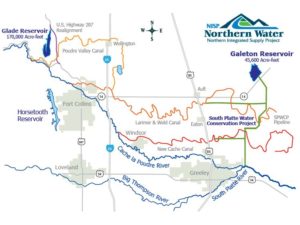 The NISP project, proposed by Northern Water, consists of two off-channel reservoirs: Glade Reservoir, northwest of Fort Collins, and Galeton Reservoir northeast of Greeley. It uses in-basin water, including the Grey Mountain project water rights that were once proposed for a mainstem reservoir in the Poudre Canyon. Galeton Reservoir facilitates down-river water exchanges, while Glade is focused on capturing peak and shoulder season flows – meaning that key impacts of concern include the loss of periodic flushing flows and overbank flows that help sustain riparian communities.
The NISP project, proposed by Northern Water, consists of two off-channel reservoirs: Glade Reservoir, northwest of Fort Collins, and Galeton Reservoir northeast of Greeley. It uses in-basin water, including the Grey Mountain project water rights that were once proposed for a mainstem reservoir in the Poudre Canyon. Galeton Reservoir facilitates down-river water exchanges, while Glade is focused on capturing peak and shoulder season flows – meaning that key impacts of concern include the loss of periodic flushing flows and overbank flows that help sustain riparian communities.
Key provisions of the Mitigation & Enhancement Plans that will benefit fishery resources on the Poudre River include:
- Base flows. A “conveyance refinement” plan to improve base flow conditions on the Poudre through most of Ft Collins, by delivering storage releases from Glade Reservoir through the river (rather than through pipelines) for about 12 river miles, to the ultimate point of diversion for delivery to the end-use cities. Under this plan, 18 cfs (winter) and 25 cfs (summer) would be delivered through the river and shepherded through diversions that currently divert 100% of the river’s flow – creating dry up points on the river during winter. The plan will use NISP deliveries to sustain base flows year-round and eliminate those dry up points.
- Fish passage. Retrofit of four cross-channel diversions on the Poudre that currently do not allow fish passage or sediment transport. The fish/sediment passage improvements will reconnect river habitat, as well as facilitating the base flow bypasses for the “conveyance refinement” plan.
- Habitat improvement. Northern Water has committed to completing 2.4 miles of river channel and habitat improvements along the Poudre. In addition, they will place another $5 million in escrow for use on other river improvement projects that are identified under a to-be-developed collaborative habitat improvement plan for the river. Another $1 million is allocated to support that planning and design process.
- Peak flows & ramping rates. CPW and Northern developed a decision-tree approach to peak flows under which different levels of peak flows will bypass the NISP diversion into Glade Reservoir depending on reservoir storage levels and snowpack conditions, as well as how recently the river has received a flushing flow. The plan helps ensure that some flush is provided even in multi-year droughts, while including a bypass of the river’s full peak flow - however high it may be - for three days during wetter periods. Increasing releases to the peak flow, and decreasing them on the tail end of it, will be implemented with a gradual “ramping rate” to avoid harmful effects to fish (such as stranding of fish out of the baseflow channel if those areas are dried up by rapidly dropping flows). TU had recommended changes to the original draft plans to incorporate ramping rates and to address flushing flows during multi-year dry periods; the final plan incorporated changes addressing both concerns.
- Adaptive management. Many elements of the plan (ramping rates, flushing flow program, habitat improvements) will be guided by a multi-stakeholder adaptive management process that will monitor conditions and help make adjustments where needed to ensure the effectiveness of the mitigation and enhancement measures. Similar to the “Learning by Doing” efforts in the Upper Colorado, this adaptive management program will ensure that efforts are informed by monitoring results and adjusted where needed. TU had recommended this program be maintained in perpetuity; the final plan calls for the program to continue for 20 years following full NISP operations (likely 25-30 years from original completion of the project) after which coordination would shift to a broader watershed coalition process that would incorporate partners and projects beyond just NISP.
“This is only the first step of several reviews that NISP must address and there are too many unanswered questions for us to yet support or oppose the project itself,” said CTU Executive Director David Nickum, “But we do support these plans and are pleased that they will assure a minimum base of protection for the Poudre’s fisheries should the project be constructed. We thank Colorado Parks and Wildlife staff for their diligence and Northern Water for their responsiveness to our and CPW’s recommendations.”
The low-flow measures are of particular importance for the Poudre’s trout fisheries from the canyon mouth through Fort Collins. “The conveyance flow program is significant to the fishery and aquatic life because it keeps water in the river on a year round basis,” said CPW biologist Ken Kehmeier. Base flows of at least 20 cfs were recommended at Lincoln Street in Ft Collins under a River Health Assessment Framework developed for the Poudre. Under current baseline conditions (without NISP), that flow is met 52% of the time. With the proposed mitigation plan, that baseflow target will be met 97% of the time. “The conveyance flow will significantly benefit the aquatic life in the river during the low flow times of the year,” Kehmeier said.



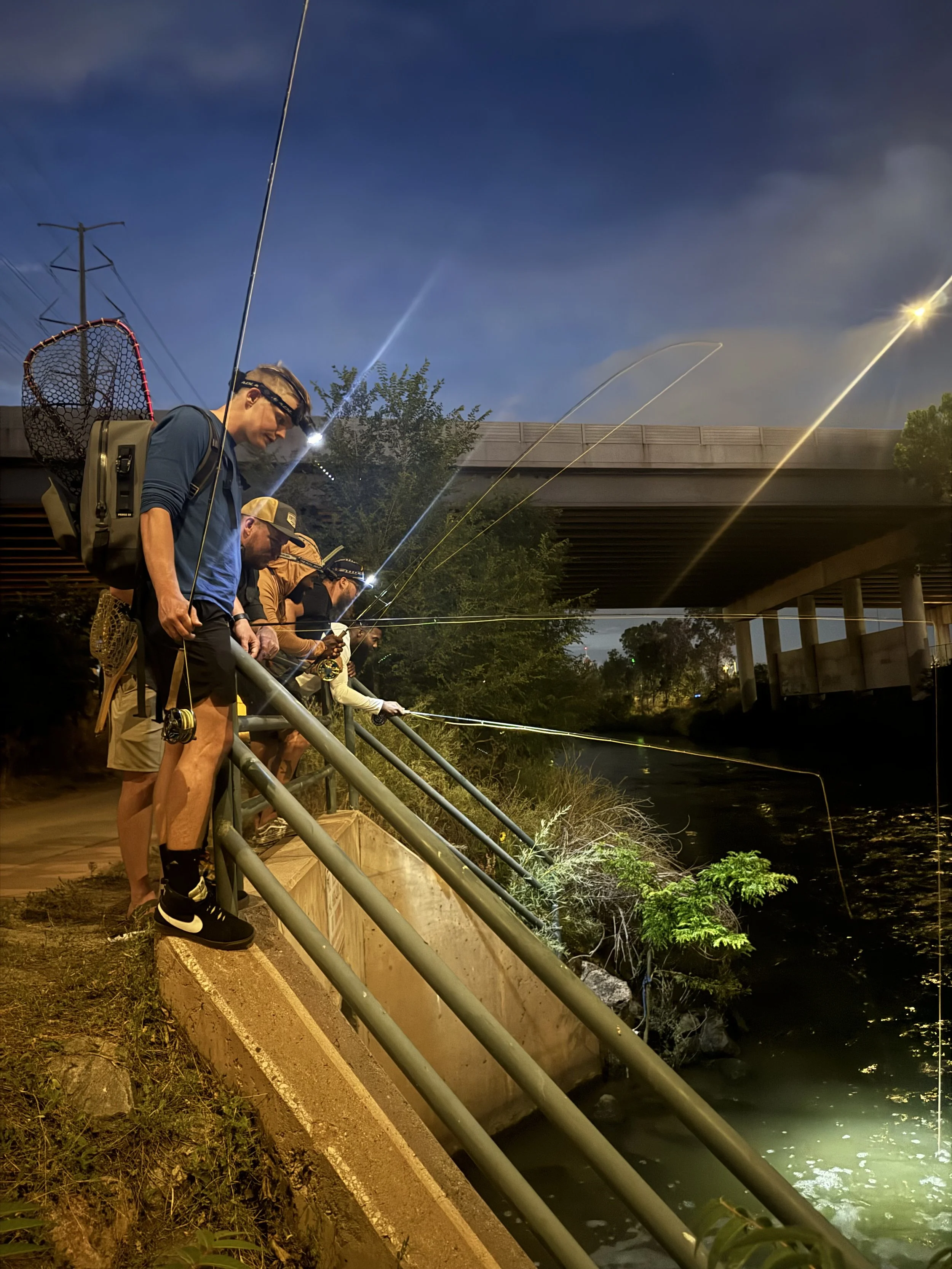



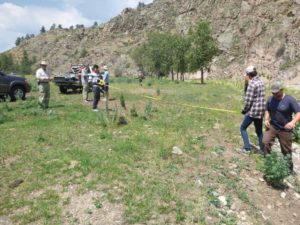 A capstone activity encompasses a half-day restoration project on a local stream, designed and supervised by the Wildlands Restoration Volunteers organization. As campers better understand the relationship of trout as an indicator of water quality, they gain appreciation for the need to protect our coldwater streams - while also discovering that fly fishing can become an enjoyable, lifelong pastime.
A capstone activity encompasses a half-day restoration project on a local stream, designed and supervised by the Wildlands Restoration Volunteers organization. As campers better understand the relationship of trout as an indicator of water quality, they gain appreciation for the need to protect our coldwater streams - while also discovering that fly fishing can become an enjoyable, lifelong pastime.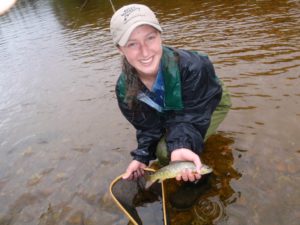 Beyond a nominal $30.00 acceptance fee, funding for camp is provided by generous corporate and individual chapter member support. Additionally, all fishing attire and equipment is provided by RMFC-TU. Camp activities occur on the Poudre River, Big Thompson River headwaters in Rocky Mountain National Park, private ponds and Fort Collins Parks. Indoor classes are held in corporate and community conference rooms.
Beyond a nominal $30.00 acceptance fee, funding for camp is provided by generous corporate and individual chapter member support. Additionally, all fishing attire and equipment is provided by RMFC-TU. Camp activities occur on the Poudre River, Big Thompson River headwaters in Rocky Mountain National Park, private ponds and Fort Collins Parks. Indoor classes are held in corporate and community conference rooms.


 Now organized by Clint Crookshanks, the Rodeo is held over the final weekend of July. Participants gather on Thursday night in Glenwood Springs to meet up and get their measuring troughs (to document the size of each of the up to 16 fish scored). On Friday, the teams spread out - fishing on public water only - to tackle the first four rivers: the Fryingpan, Roaring Fork, Crystal, and Colorado. On Saturday, action moves to the Gunnison basin with teams fishing the East, Gunnison, and Taylor Rivers as well as Spring Creek. If an angler misses one of the Friday rivers, they can make it up with the Slate as a fifth Saturday river.
Now organized by Clint Crookshanks, the Rodeo is held over the final weekend of July. Participants gather on Thursday night in Glenwood Springs to meet up and get their measuring troughs (to document the size of each of the up to 16 fish scored). On Friday, the teams spread out - fishing on public water only - to tackle the first four rivers: the Fryingpan, Roaring Fork, Crystal, and Colorado. On Saturday, action moves to the Gunnison basin with teams fishing the East, Gunnison, and Taylor Rivers as well as Spring Creek. If an angler misses one of the Friday rivers, they can make it up with the Slate as a fifth Saturday river. We stayed in Basalt and made it to the dam before sunrise. Only to find a line of folks already in place waiting to cast into the pool immediately below the dam. We went a bit downstream, crossed to the opposite side, and fished the far bank. Dustin landed his fish first - not a trophy, but a nice 15" brown trout. We relocated below the bridge where I landed a 12"er and was thus able to record my first Rodeo trout on the Fryingpan. One river down - and not even 9 am. We were flying high!
We stayed in Basalt and made it to the dam before sunrise. Only to find a line of folks already in place waiting to cast into the pool immediately below the dam. We went a bit downstream, crossed to the opposite side, and fished the far bank. Dustin landed his fish first - not a trophy, but a nice 15" brown trout. We relocated below the bridge where I landed a 12"er and was thus able to record my first Rodeo trout on the Fryingpan. One river down - and not even 9 am. We were flying high! Colorado while Dustin continued to hit the Roaring Fork - but close enough where we could both get to the other with the measuring trough if we landed something. We struck out there. Crossing the bridge and dropping to the opposite bank, Dustin caught our best fish of the weekend - an 18" whitefish. I continued to get nothing.
Colorado while Dustin continued to hit the Roaring Fork - but close enough where we could both get to the other with the measuring trough if we landed something. We struck out there. Crossing the bridge and dropping to the opposite bank, Dustin caught our best fish of the weekend - an 18" whitefish. I continued to get nothing. Saturday started with high hopes to get fish from five rivers and still complete our rodeo. But the luck that had been with me on the Colorado left me on the Gunnison. Fishing below the town of Gunnison in the morning, I hooked - and lost - a series of three fish. Dustin was also having no luck, so we decided a change of scenery was in order. We headed up to the Taylor River where we found a beautiful pool - complete with a break in the riverside trees to allow for a clear backcast - and both hooked into rising browns to score our Taylor River fish. Four rivers down - four to go.
Saturday started with high hopes to get fish from five rivers and still complete our rodeo. But the luck that had been with me on the Colorado left me on the Gunnison. Fishing below the town of Gunnison in the morning, I hooked - and lost - a series of three fish. Dustin was also having no luck, so we decided a change of scenery was in order. We headed up to the Taylor River where we found a beautiful pool - complete with a break in the riverside trees to allow for a clear backcast - and both hooked into rising browns to score our Taylor River fish. Four rivers down - four to go. headed over to the Roaring Judy Hatchery to fish the public reach of the East River there. Fishing around a tree with branches hanging over the river by where the hatchery springs flow out into the East, Dustin landed another brown trout. We swapped rigs, figuring that his set up would give me the best chance to land one as well. Of course, Dustin proceeded to hook another fish on my rod and fly ... another lesson in humility for me.
headed over to the Roaring Judy Hatchery to fish the public reach of the East River there. Fishing around a tree with branches hanging over the river by where the hatchery springs flow out into the East, Dustin landed another brown trout. We swapped rigs, figuring that his set up would give me the best chance to land one as well. Of course, Dustin proceeded to hook another fish on my rod and fly ... another lesson in humility for me. We finished the evening fishing the Gunnison at its source - the confluence of the East and Taylor Rivers - as a light rain continued to fall. While we hadn't succeeded - indeed, hadn't even come particularly close - it had been a great experience to fish together at so many different, beautiful spots in such a short time. We called it a day and headed over to the Almont Resort for dinner.
We finished the evening fishing the Gunnison at its source - the confluence of the East and Taylor Rivers - as a light rain continued to fall. While we hadn't succeeded - indeed, hadn't even come particularly close - it had been a great experience to fish together at so many different, beautiful spots in such a short time. We called it a day and headed over to the Almont Resort for dinner. Slate to replace the Crystal, which they like us had missed on Friday). Those well-earned smiles on their faces come with one year's worth of bragging rights - at least until the 2018 Rodeo. Overall, 12 of the 30 teams completed all 8 rivers. For the 10th anniversary year, there was also the option to complete 10 rivers (adding Brush Creek and Cement Creek on Friday and Saturday respectively). Three teams actually completed all 10 rivers - including the overall winners, the Triple Haulin' Nymphers (Dan Lundahl and Earl Hecker), who scored 257.3 inches on the 8 rivers (that's an average fish length of 16 inches!) plus another 51.8 inches on the two bonus rivers.
Slate to replace the Crystal, which they like us had missed on Friday). Those well-earned smiles on their faces come with one year's worth of bragging rights - at least until the 2018 Rodeo. Overall, 12 of the 30 teams completed all 8 rivers. For the 10th anniversary year, there was also the option to complete 10 rivers (adding Brush Creek and Cement Creek on Friday and Saturday respectively). Three teams actually completed all 10 rivers - including the overall winners, the Triple Haulin' Nymphers (Dan Lundahl and Earl Hecker), who scored 257.3 inches on the 8 rivers (that's an average fish length of 16 inches!) plus another 51.8 inches on the two bonus rivers.
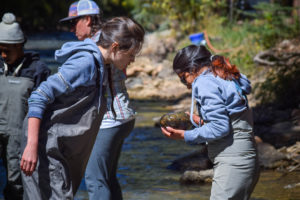
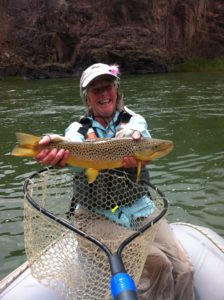
 What made you want to become involved with TU?
I grew up loving to volunteer and help others; during my involvement with the Boy Scouts of America from Cub Scout to Eagle Scout and beyond, I get a great sense of satisfaction from philanthropic endeavors. Oh- and I love to fish, so I should do my part to keep our waters clean, cold and fishable for generations to come. There is nothing better than a day on the river, (besides a day on the river catching fish) so I love being part of an organization where our work benefits my favorite pastime!.
What made you want to become involved with TU?
I grew up loving to volunteer and help others; during my involvement with the Boy Scouts of America from Cub Scout to Eagle Scout and beyond, I get a great sense of satisfaction from philanthropic endeavors. Oh- and I love to fish, so I should do my part to keep our waters clean, cold and fishable for generations to come. There is nothing better than a day on the river, (besides a day on the river catching fish) so I love being part of an organization where our work benefits my favorite pastime!. What else do you do in your spare time or for work?
I am a water resource engineer and I specialize in stream restoration and watershed management. If I am not fishing I am skiing. My entire life from professionally to personally revolves around water. My wife and I love backpacking, hiking to cool spots and exploring our amazing state with our dogs.
What else do you do in your spare time or for work?
I am a water resource engineer and I specialize in stream restoration and watershed management. If I am not fishing I am skiing. My entire life from professionally to personally revolves around water. My wife and I love backpacking, hiking to cool spots and exploring our amazing state with our dogs.




